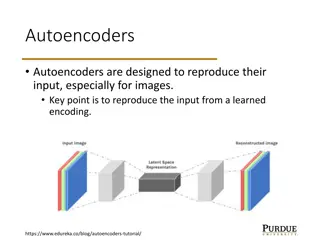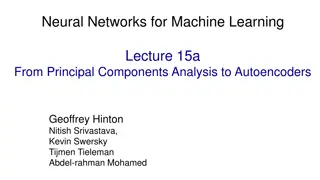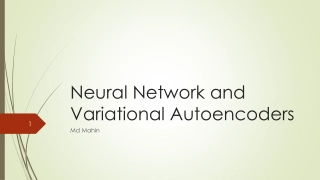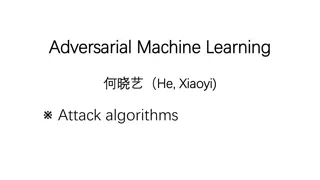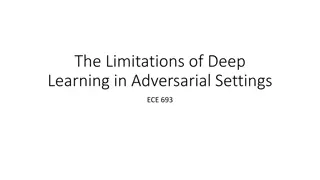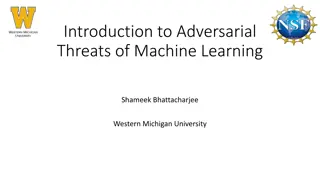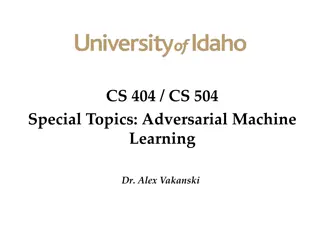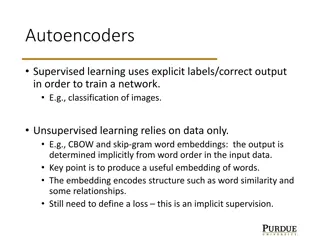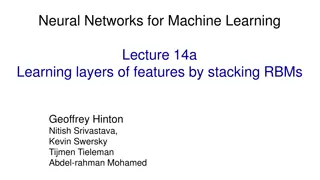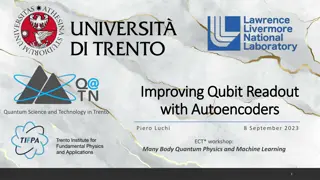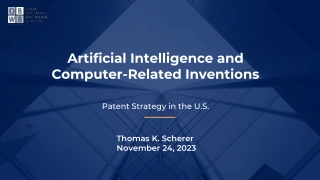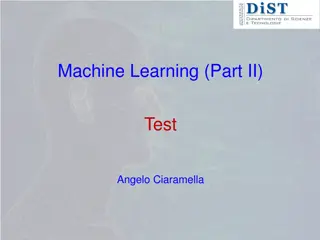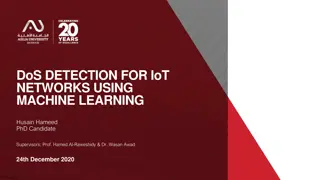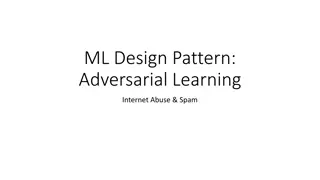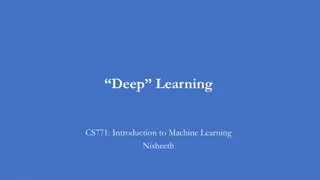Variational Autoencoders (VAEs) and Generative Adversarial Networks (GANs) in Machine Learning
Introduction to Generative Models with Latent Variables, including Gaussian Mixture Models and the general principle of generation in data encoding. Exploring the creation of flexible encoders and the basic premise of variational autoencoders. Concepts of VAEs in practice, emphasizing efficient sampling techniques and Q(z|x) estimation.
- Variational Autoencoders
- Generative Adversarial Networks
- Machine Learning
- Latent Variable Models
- Gaussian Mixture Models
Download Presentation

Please find below an Image/Link to download the presentation.
The content on the website is provided AS IS for your information and personal use only. It may not be sold, licensed, or shared on other websites without obtaining consent from the author. Download presentation by click this link. If you encounter any issues during the download, it is possible that the publisher has removed the file from their server.
E N D
Presentation Transcript
VAEs and GANs CS771: Introduction to Machine Learning Nisheeth
2 Generative Models with Latent Variables We have already looked at latent variable models in this class Used for Clustering Dimensionality reduction Broadly, latent variable models approximate the distribution on X Latent variable z_n usually encodes some latent properties of the observation ?? ?? ?? Can apply this approximation in a variety of applications Such as generation of new examples CS771: Intro to ML
Example: Gaussian Mixture Model (categorical) We can sample X that looks like it was from p(X) P(x) P(m) .. 1 2 3 4 5 CS771: Intro to ML
A general principle of generation Data is encoded into a different representation New data is generated by sampling from the new representation GMMs are just one type of encoding-decoding scheme Image credit (link) CS771: Intro to ML
Creating flexible encoders Actually, What about the data distribution of this random variable Y? Easy to encode this data distribution of a random variable X with a bivariate Gaussian CS771: Intro to ML
Variational auto-encoders: the basic premise Any distribution in d dimensions can be generated by taking a set of d normally distributed random variables and mapping them through a sufficiently complex function We use a neural network encoder to learn this function from data Image credit (link) CS771: Intro to ML
VAEs concept Each dimension of z represents a data attribute ? ? ? NN p(x) Infinite Gaussian We approximate complex p(x) as a composition of many simple z z CS771: Intro to ML
VAEs in practice Brute force approximation of P(X) Sample a large number of z values Compute Problem, when z is high dimensional, you d need a very large n to sample properly VAEs try to sample p(X|z) efficiently Key idea: the X z mapping is sparse in a large enough neural network Corollary: most p(X|z) will be zero Rather than directly sample P(X|z), we try and estimate Q(z|x) that gives us the z that are most strongly connected with any given x VAEs assume Q are Gaussian 8 CS771: Intro to ML
The VAE objective function We want to minimize Which is equivalent to maximizing VAE assumes that we can define some Q(z|X) that maximizes The RHS is maximized using stochastic gradient descent, sampling a single value of X and z from Q(z|X) and then calculating the gradient of See here for derivations and a more detailed explanation CS771: Intro to ML
What a VAE does Generate samples from a data distribution For any data Cool applications ? decode code noise noise encode CS771: Intro to ML
VAE outputs Samples from a VAE trained on a faces dataset Samples from a VAE trained on MNIST CS771: Intro to ML
VAE limitations People have mostly moved on from VAEs to use GANs for generating synthetic high-dimensional data VAEs are theoretically complex Don t generalize very well Are pragmatically under-constrained Reconstruction error need not be exactly correlated with realism Fake Realistic CS771: Intro to ML
Generative adversarial networks (GANs) VAEs approximate P(X) using latent variables z, with the mapping between X and z pushed through a NN function approximation that ensures that the transformed data can be well represented by a mixture of Gaussians But approximating P(X) directly is complicated, and approximating it well in the space of an arbitrarily defined reconstruction error does not generalize well in practice GANs go about approximating P(X) using an indirect approach CS771: Intro to ML
Adversarial training Two models are trained a generator and a discriminator The goal of the discriminator is to correctly judge whether the data it is seeing is real, or synthetic Objective function is to maximize classification error The goal of the generator is to fool the discriminator It does this by creating samples as close to real data as possible Objectively tries to minimize classification error No longer reliant on reconstruction error for quality assessment Fake Realistic CS771: Intro to ML
GANs NN NN NN Generator v3 Generator v2 Generator v1 Discri- minator v3 Discri- minator v2 Discri- minator v1 Real images: CS771: Intro to ML
GAN - Discriminator Vectors from a distribution NN Generator 0 0 0 0 Decoder in VAE Real images: 1 1 1 1 1/0 (real or fake) image Discriminator Can be a convnet CS771: Intro to ML
Randomly sample a vector GAN - Generator NN Generator v1 Tuning the parameters of generator The output be classified as real (as close to 1 as possible) Generator + Discriminator = a network Use gradient descent to find the parameters of generator Discriminator v1 1.0 0.87 CS771: Intro to ML
GAN outputs The latent space learned in GANs is very interesting People have showed that vector additions and subtractions are meaningful in this space Can control novel item compositions almost at will A big deepfakes industry is growing up around this For more details, see here CS771: Intro to ML
Summary In CS771, you have learned the basic elements of ML Representing data as multidimensional numerical representations Defining model classes based on different mathematical perspectives on data Estimating model parameters in a variety of ways Defining learning objectives mathematically, and optimizing them Evaluating outcomes, to some degree What will you do with this knowledge? CS771: Intro to ML



